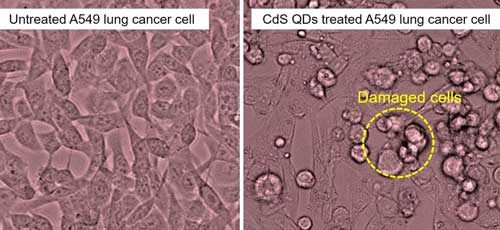| Posted: May 21, 2018 |
Nanoparticles derived from tea leaves destroy lung cancer cells
(Nanowerk News) Nanoparticles derived from tea leaves inhibit the growth of lung cancer cells, destroying up to 80% of them, new research by a joint Swansea University and Indian team has shown.
|
|
The team made the discovery while they were testing out a new method of producing a type of nanoparticle called quantum dots. These are tiny particles which measure less than 10 nanometres.
|
|
Although nanoparticles are already used in healthcare, quantum dots have only recently attracted researchers' attention. Already they are showing promise for use in different applications, from computers and solar cells to tumour imaging and treating cancer.
|
|
Quantum dots can be made chemically, but this is complicated and expensive and has toxic side effects. The Swansea-led research team were therefore exploring a non-toxic plant-based alternative method of producing the dots, using tea leaf extract.
|
 |
| These are microscope images of A549 lung cancer cell; left = untreated; right = treated with quantum dots. (Image: Swansea University)
|
|
Tea leaves contain a wide variety of compounds, including polyphenols, amino acids, vitamins and antioxidants. The researchers mixed tea leaf extract with cadmium sulphate (CdSO4) and sodium sulphide (Na2S) and allowed the solution to incubate, a process which causes quantum dots to form. They then applied the dots to lung cancer cells.
|
|
They found:
|
|
Tea leaves are a simpler, cheaper and less toxic method of producing quantum dots, compared with using chemicals, confirming the results of other research in the field.
Quantum dots produced from tea leaves inhibit the growth of lung cancer cells. They penetrated into the nanopores of the cancer cells and destroyed up to 80% of them. This was a brand new finding, and came as a surprise to the team.
|
|
The research, published in Applied Nano Materials ("Green-Synthesis-Derived CdS Quantum Dots Using Tea Leaf Extract:Antimicrobial, BioImaging and Therapeutic Applications in Lung Cancer Cells"), is a collaborative venture between Swansea University experts and colleagues from two Indian universities.
|
|
Dr Sudhagar Pitchaimuthu of Swansea University, lead researcher on the project, and a Ser Cymru-II Rising Star Fellow, said: "Our research confirmed previous evidence that tea leaf extract can be a non-toxic alternative to making quantum dots using chemicals.
|
|
The real surprise, however, was that the dots actively inhibited the growth of the lung cancer cells. We hadn't been expecting this.
|
|
The CdS quantum dots derived from tea leaf extract showed exceptional fluorescence emission in cancer cell bioimaging compared to conventional CdS nanoparticles.
|
|
Quantum dots are therefore a very promising avenue to explore for developing new cancer treatments.
|
|
They also have other possible applications, for example in anti-microbial paint used in operating theatres, or in sun creams."
|
|
Dr Pitchaimuthu outlined the next steps for research: "Building on this exciting discovery, the next step is to scale up our operation, hopefully with the help of other collaborators. We want to investigate the role of tea leaf extract in cancer cell imaging, and the interface between quantum dots and the cancer cell.
|
|
We would like to set up a "quantum dot factory" which will allow us to explore more fully the ways in which they can be used."
|

